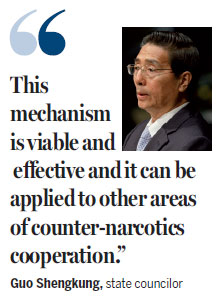Drug fight focuses on the Mekong Delta
Helping fight the illicit drug trade in the Southeast Asian region remains a priority for China, said Chinese State Councilor Guo Shengkung.
The area is continuing to see year-on-year increases in the number of drug-related arrests and users admitted for drug treatment, despite significant efforts from six countries in East and Southeast Asia - China, Cambodia, Laos, Myanmar, Thailand, Vietnam - to limit the flow of drugs throughout the region and to the rest of the world.
"This mechanism is viable and effective and it can be applied to other areas of counter-narcotics cooperation," Guo said on Tuesday at an event held on the sidelines of the United Nations General Assembly Special Session (UNGASS) on the world drug problem.
The event highlighted the work done by the six countries as designated under the Mekong MOU, named after the trans-border river in Southeast Asia where much of the region's drug trade occurs.
China's participation in the region includes establishing a joint law enforcement and security cooperation mechanism with Laos, Myanmar and Thailand, which fights against organized smuggling, illegal migration and apprehending fugitives, according to a China policy report released by the S. Rajaratnam School of International Studies at the Nanyang Technological University.

"All signatory parties [under the MOU] need to work together and plan for future development," Guo said, and expand drug control cooperation under the Mekong mechanism. The countries must also increase cooperation with other regions and countries, he added.
"Within this framework, China will continue to cooperate with other countries," increasing its contribution by providing funds and technology to address the drug problems in the region, he said.
The drug trade within the Mekong region is dominated by the production and trafficking of opiates and synthetic drugs. Heroine flows continue to move "almost unchecked from the Golden Triangle", said Jeremy Douglas, regional representative for Southeast Asia and the Pacific at the United Nations Office on Drugs and Crime (UNODC).
The region is also home to a large number of precursor producers, which are chemicals used to make the drugs, with India and China being the two largest sources because of their respective pharmaceutical industries.
While the region's interconnectivity has brought about economic benefits and mutual trade, it has also connected "precursor flows where precursors are needed", Douglas said.
To counter the trade, the UNODC and the six countries have developed 70 border liaison offices across the region, which allows for more rapid cross-border cooperation to prevent illicit flows. The UNODC is also discussing with the states to increase the number of these offices.
Later this year, the UNODC will conduct a drug use survey in Myanmar to better understand how users are using drugs and getting access to the drugs.
China will host a training seminar next month that helps drug practitioners learn how to work closer with drug consumers.
This region suffers from "very significant challenges compared to other regions in the world", but these plans of actions will ultimately benefit Mekong countries and the wider world, Douglas said.
amyhe@chinadailyusa.com




















